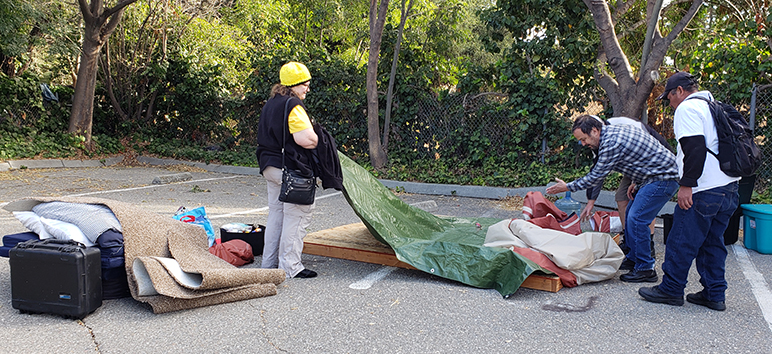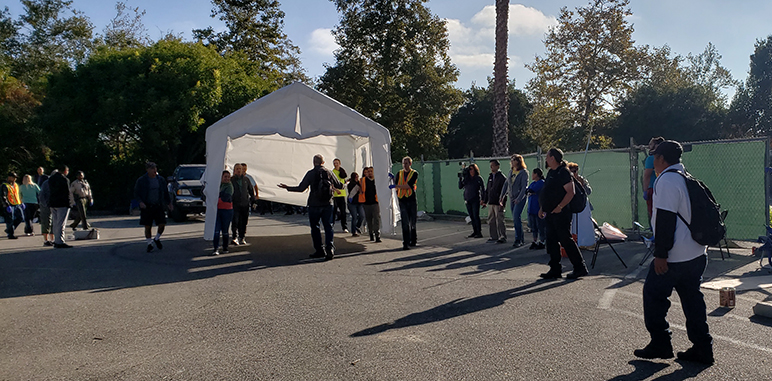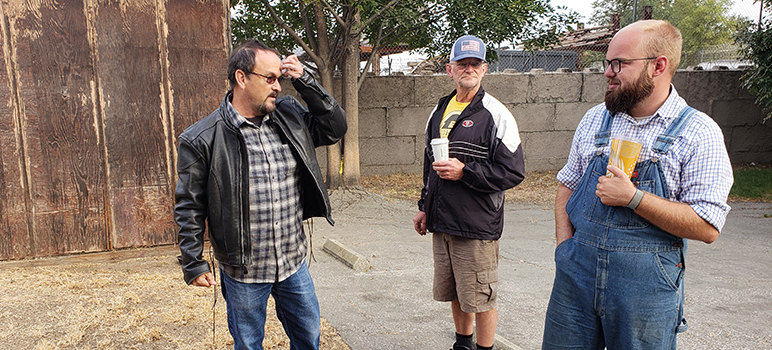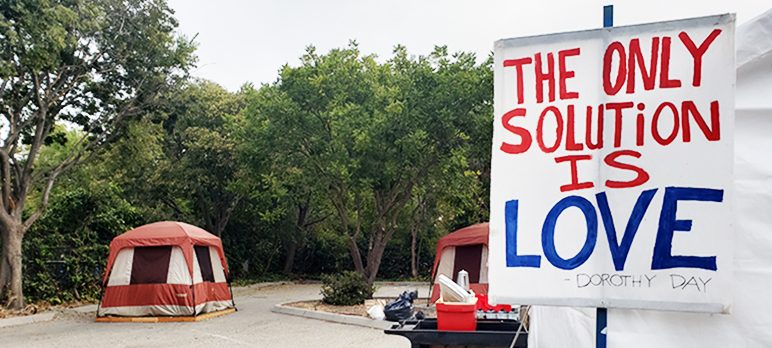San Jose’s Hope Village stood for a full week after the California Highway Patrol gave the unsanctioned homeless camp 72 hours to clear out. But the grace period ended today.
From 7:30am to late morning Monday, the camp’s six homeless residents joined volunteers and orange-vested arrestees sentenced to community service to dismantle tents, pack up lockboxes and haul everything down the street to a temporary site.
While the camp sprang up in secret Sept. 8 on an empty parking lot by Ruff Drive and Hedding Street, an audience of TV news reporters and local dignitaries this morning watched it leave. To Curtis—a 53-year-old Hope Village tenant who withheld his surname—the spotlight felt overwhelming after seven years of homelessness.
“You get used to nobody seeing you,” he said, pausing to survey the scene while the camp’s resident dog, whippet-Chihuahua mix Lucky, excitedly scampered around. “And now, all of a sudden, everybody’s here—not just today, it’s been like that all week.”

Volunteers dismantle Hope Village in time for the CHP's deadline of 12pm Monday. (Photo: Jennifer Wadsworth)
Though its future remains uncertain, Hope Village accomplished in a matter of days what no elected leader in the South Bay has had the political will or vision to pull off.
The uninvited, un-permitted and privately funded pilot project created a real-world model for a safe, organized encampment as a short-term reprieve for the unsheltered. It was clean and orderly with strict rules against drugs and drinking and thorough screening for residents. It offered privacy, security, a portable toilet, tents on sturdy wood platforms and running water by way of a mobile shower. The stability helped one resident, 63-year-old handyman and camp host Charlie Nelson, find a job.
“It seems that all up and down the political levels here, people have realized that this is a viable alternative for those who are on the street and it needs to be given a chance,” said Peter Miron-Conk, 72, co-founder of the nonprofit Casa de Clara Catholic Worker and one of the lead organizers of the camp. “There was a lot of hostility and resistance to the idea of sanctioned encampments, and it looks like we’ve won that battle.”
For a day or so, it looked like the CHP would allow Hope Village to stay despite pushback from the nearby office of the California Employment Development Department (EDD), which owns the rarely-used lot across from a long-abandoned traffic court.
The 72-hour deadline came and went Thursday with no enforcement from state police. But Hope Village volunteers received an email early Friday warning that the eviction would proceed. CHP officers relayed the same message around 6:30pm that evening, well after government offices had closed for the day, and said the new deadline was set for 8am the following Monday.
“The CHP spoke with the group and issued a courtesy notice allowing the group 72 hours to make alternative accommodations, as they were illegally trespassing and occupying state property without proper permits,” the agency’s San Jose division explained in a Facebook post this afternoon. “The CHP has been working with city and county officials to try to find a suitable location for the Hope Village individuals and move them from EDD property. CHP has taken a very humanistic approach and understands the complexities of the circumstances. For that reason, the CHP extended the order to move several times while a resolution was sought.”

Volunteers carried a canopy used as the camp's common area to the union hall down the road. (Photo: Jennifer Wadsworth)
Thankfully, organizers—a core group comprising Miron-Conk, Jacquie Heffner, Edie and Robby Brodsky, Karen Lattin and Andrew Lanier—had direct lines to state legislators. They called state Sen. Jim Beall (D-San Jose), Assemblyman Ash Kalra (D-San Jose) and Assemblyman Evan Low (D-San Jose), urging them to intervene. Activists and local officials emailed and phoned Gov. Jerry Brown’s office imploring him for help, too.
All that attention bought Hope Village more time and pressured the powers that be to find another site for the camp. SEIU-USWW offered a grassy plot next to its union hall until Santa Clara County identifies a publicly owned place to host it, as promised by supervisors Cindy Chavez and Dave Cortese. San Jose Councilman Don Rocha, who’s running for county supervisor, penned a memo directing the city to help in the search.
“We’ve set things in motion,” Miron-Conk reflected the night before the early morning eviction. “But we’re still trying to figure out where to take things from here.”
San Jose has toyed with the notion of sanctioned encampments ever since dismantling “The Jungle,” one of the nation’s largest homeless settlements, back in 2014. San Jose Councilman Tam Nguyen even spent the night at a permitted camp up in Eugene, Oregon, as part of a study mission.
The idea never materialized.
Mayor Sam Liccardo opposed sanctioned encampments in favor of permanent supportive housing, and an effort to build tiny sleeping cabins for the homeless ran into one delay after another because of community backlash.
In 2016, the city teamed up with Santa Clara County to solicit bids for a pilot project, but it “did not yield any successful applications that could address the potential regulatory issues of sanctioned encampments, leaving no viable option to provide such a program in either a time or cost effective manner,” San Jose Housing Director Jacky Morales-Ferrand concluded in an Aug. 28, 2017, report to the council.
Miron-Conk and a grassroots coalition of volunteers created Hope Village out of both compassion and frustration—compassion for the homeless and frustration with local agencies for spending millions of dollars a year clearing encampments and displacing people with nowhere else to stay.
“We recognize that this isn’t a permanent solution,” Miron-Conk said, “but where are people going to go in the meantime?”
Several elected officials who declined to publicly endorse the Hope Village before it opened reconsidered their stance on sanctioned camps after visiting the site in person. In addition to Nguyen, council members Dev Davis, Sergio Jimenez and Vice Mayor Magdalena Carrasco have voiced their support for Hope Village. As have Alum Rock Union schools candidate Ray Mueller and San Jose Unified trustee Susan Ellenberg, who’s running against Rocha for county supervisor, and her board colleague Michael Melillo. Brian Wheatley, who’s challenging Melillo this fall, and Helen Chapman, who’s vying to succeed Ellenberg, appeared alongside them at today’s pre-eviction rally.
On Saturday, Morales-Ferrand went to see Hope Village in person. Though she raised concerns about liability issues, she assured the volunteers and residents that her staff would redouble efforts to find a suitable property for the camp. The following day, Liccardo stopped by and expressed similar misgivings, but told Miron-Conk and the others that his office has been calling Gov. Brown for help.
While Hope Village awaits word from Sacramento, the county and city have set dates to discuss the next steps. Rocha’s memo directs staff to find a new site and return to the council with a progress report by Oct. 23.
“Elected officials at different levels of government, members of the media, individuals living in the encampment, and San Joseans in general seem to agree this was a well-organized and bold effort to provide a much needed alternative for unsheltered homeless individuals living along not only our highways and streets, but in our parks and creeks,” he wrote in the proposal, which came before the Rules and Open Government Committee last week. “This privately-funded effort is providing seven individuals access to tents, common areas and hygienic facilities which can be crucial in allowing homeless residents to recapture a semblance of normalcy which can help get them back on their feet.”
The plan introduced by Cortese and Chavez directs county staff to drum up a similar report by the Oct. 16 Board of Supervisors session. In a joint memo, they note that housing remains the only sure solution for homelessness, but acknowledge that organized camps could offer temporary relief.
“In contrast to illegal encampments, this model seeks to create a more humane and secure environment for the homeless,” they wrote. Later in the memo, they add: “Although the county has acted robustly, including quintupling the number of year-round shelter beds, it is clear more must be done to address the human misery of the unhoused and unsheltered. ... Therefore, it is worthwhile to explore the Hope Village model to determine its efficacy and capacity for replication.”
Miron-Conk said he’s heartened by the support, but has some doubts and knows it takes continuous work to make sure public officials follow through once the spotlight dims.
“You know, it looks like a lot of these officials have seen the light,” he reflected. “The question now is, how deep does this run?”

Volunteer Mark Metzler (from left), Hope Village resident Curtis and Casa de Clara Catholic Worker's Andrew Lanier survey the temporary site beside the union hall. (Photo: Jennifer Wadsworth)


> The Only Solution is Love
I LOVE it when hobos are bused to hobo reservations that are not in my back yard.
Go ahead. Call me a NIMBY.
* “not in my back yard” means anyplace NOT claiming any of my tax dollars.
Please ship all the homeless people to newby landfill, where there are plenty of trash and open space homeless can comfortably make a living.
Love is the solution? I cant wait to get out of this silly liberal cesspool.
Thank you Jennifer for writing this article. I am so glad the Village is not being disbanded and I hope the City can learn something from the people running it. While this is not a permanent solution, perhaps more of these sites can be developed to help these individuals and also keep our City clean. Thanks to Assembly member Ash Kalra and others who made the community aware of the situation and asked us to place calls to support this village.
Artifacts of the ongoing gentrification of San Jose in preparation for the Googlers can be found everywhere! I found that the owners of the 7-Eleven at Bird and Virginia deny EBT credit services to their economically Disadvantaged customers! San Jose bureaucrats and business owners know where their bread will be buttered and are more than willing to accommodate. This includes our education bureaucrats who provide substandard education service to the poor as well. Check out the gap at http://sipbigpicture.com!
“In contrast to illegal encampments, this model seeks to create a more humane and secure environment for the homeless,” they wrote. Later in the memo, they add: “Although the county has acted robustly, including quintupling the number of year-round shelter beds, it is clear more must be done to address the human misery of the unhoused and unsheltered. … Therefore, it is worthwhile to explore the Hope Village model to determine its efficacy and capacity for replication.”